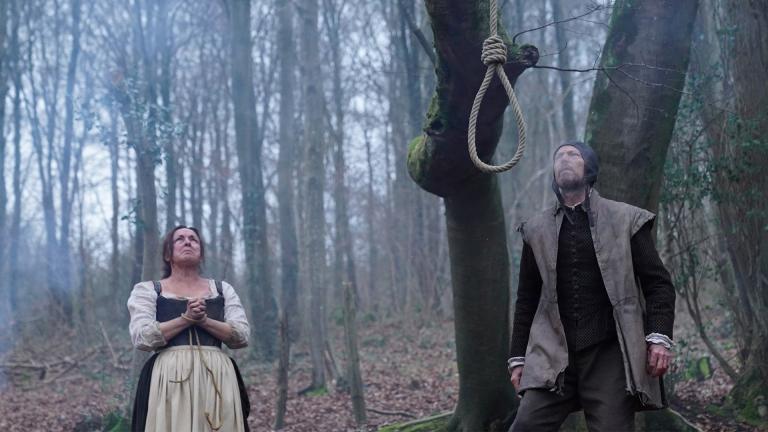
Read more about Popular Culture

As the ‘witch craze’ swept across Europe, hundreds of alleged witches are thought to have been executed in England alone. An especially high proportion of these victims met their fate in Essex.
Between 1570 and 1609, the southwest county saw 53 people (mainly women) found guilty of witchcraft and subsequently sentenced to death. Several of the dubious trials are investigated in a new Sky HISTORY series, Witches of Essex.
Alarmingly, the spate of witch hunts that rocked the 16th and 17th centuries started even earlier than 1570. We at Sky HISTORY are especially intrigued by the series’ first episode, which looks at how elderly widow Agnes Waterhouse lost her life. Witches of Essex starts Tuesday 14 October 9pm on Sky HISTORY and HISTORY Play.
Various developments over the preceding decades are thought to have contributed. One is the 1486 publication of the treatise Malleus Maleficarum (‘Hammer of Witches’), credited to German clergyman Heinrich Kramer.
In its pages, Kramer urged courts to take tough action against the scourge of sorcery. In the early 1540s, King Henry VIII introduced his Witchcraft Act, which made even just the practice of witchcraft a capital offence in England.
In 1563, this legislation was revised by Queen Elizabeth I’s Witchcraft Act. While witchcraft 'whereby any person shall happen to be killed or destroyed' was still punishable by death, lesser offences would instead lead to imprisonment.
In 1566, a few years after the Queen’s Witchcraft Act was passed, three women from the Essex village of Hatfield Peverel stood accused. The women in question were Agnes Waterhouse and two relatives: her sister Elizabeth Francis and daughter Joan Waterhouse.
Unsurprisingly, many defendants of the time would strenuously deny allegations of witchcraft, as their lives would be on the line otherwise. However, Agnes and Elizabeth both confessed. The trial was held in Chelmsford – to be more exact, near the present-day Shire Hall in Tindal Square.
During the Elizabethan period, it was thought that many witches would conduct their sorcery with the help of ‘familiars’. This word referred to supposed spiritual entities capable of manifesting themselves as animals, such as pets.
At Chelmsford Assizes, Elizabeth Francis admitted to owning a familiar – in this case, a cat called Sathan. Elizabeth claimed responsibility for the death of her boyfriend, who refused to marry her. According to Elizabeth, she eventually gave the cat to her sister Agnes in exchange for cake.
As for what Agnes reportedly did with the cat, that really got tongues wagging. She testified to using Sathan to kill a range of local livestock, including pigs, cows and geese. The story goes that some of these animals were murdered out of spite, as they were owned by neighbours Agnes did not get along with.
At the trial, a local 12-year-old girl, Agnes Brown, claimed to have been haunted by a horned, black, short-tailed dog with an ape’s face. She said that after she declined the terrifying creature’s request for butter, he helped himself to butter from the family’s dairy.
The dog later visited again with a knife and threatened the little girl’s life. When she asked the dog who his ’dame’ was, he wagged his head towards Agnes Waterhouse’s home. This report was seen as incriminating evidence, and contributed to the court’s eventual damning verdict against the widow.
Agnes Waterhouse was ultimately found guilty of witchcraft charges, including those of sickening and killing a local man, William Fynne. As a result, she was hanged at the Chelmsford gallows on 29th July 1566. Elizabeth was handed a lighter sentence, while Joan was acquitted.
Today, historians are surprised by how willingly Agnes confessed to witchcraft. One theory is that she was angling to save her daughter Joan’s life. By openly accepting all responsibility for witchcraft, Agnes could potentially deflect any blame directed at Joan.
The plights of Agnes Waterhouse, Joan Waterhouse and Elizabeth Francis are dramatised in Witches of Essex. This Sky HISTORY series also explores other intricacies of the case.
For example, attention is paid to Agnes’s Catholic faith. Her practice of the old religion – banned in Elizabethan England, a Protestant country – further convinced contemporaries of the defendant’s guilt.
You can expect to see yet more Tudor-themed shows air on Sky HISTORY in the foreseeable future, too. By subscribing to our Newsletter, you can get enticing email updates about what’s coming up.